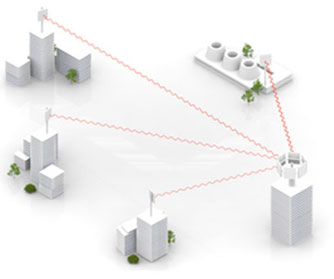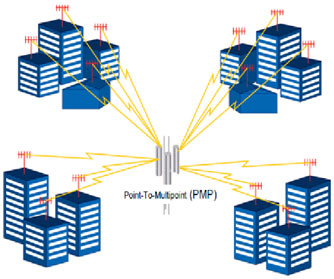POINT TO POINT RF NETWORKS

Legend IT offers several choices for PTP solutions in the unlicensed RF spectrum . Note that Legend IT PMP products are also listed as PTP solutions since PMP products can also serve PTP applications. Refer to the products page to find out more about Legend IT fine assortment of PTP wireless data networking products or continue to explore the Technology topics to help you understand which specific products are best suited for you.
Why PTP networks are needed and how it compares works with PMP networks.
Point-to-point (PTP) RF data networking refers to the use of wireless (RF) technologies to create a data link between two … exactly two … locations. PTP wireless data networks tend to require high data throughput over long distances.
PTP is different from point-to-multipoint (PMP) in two key ways. First, PMP has more than two locations. Second, because there are more than two locations all sharing the same access media (the RF channel), the control and use of the RF channel becomes more complex.
Even within the “unlicensed” RF spectrum there are still regulatory requirements placed on the RF equipment. These regulatory requirements are typically different for PTP products than for PMP (sometimes very different). Most typically, these regulatory requirements deal with limiting the strength of the RF transmission. Just to make things more complicated, these restrictions are often placed on the RF equipment itself (TX power) and also on the combined affect of the RF equipment and the RF antenna (EIRP). PTP regulatory limits are typically higher than those for PMP products.
Wireless PTP data links typically do not require much in the way of network services. As a result, PTP devices typically operate as simple (Ethernet) bridges and leave services such as routing and traffic policing to the networks they are connecting. In a sense, a PTP wireless link becomes an invisible “cable” joining two data network devices. Without wireless technology, distances of over 100 meters typically must be served by wide area network (WAN) technologies such as T1/E1 and fiber. However, wireless data networking allows for local area network (LAN) technologies such as 10-BaseT to be used. These technologies are not only less expensive but they are more readily available as well … just about every computer now has an Ethernet network interface (NIC) port. This means that computers can be directly connected to each other using wireless PTP technology even if they are separated by many miles/kilometers.
POINT TO MULTIPOINT RF NETWORKS

Legend IT offers several choices for PMP solutions covering the whole unlicensed RF spectrum. Refer to the products page to find out more about Legend IT fine assortment of PMP wireless data networking products or continue to explore the Technology topics to help you understand which specific products are best suited for you.
A short description of the complexities and challenges to why PMP systems are needed. Legend IT PMP solutions cover unlicensed and licensed RF spectrum.
Point-to-Multipoint (PMP) RF data networking refers to the use of wireless (RF) technologies to create one or more data links. These data links all originate at a single location (the “point” of PMP) and fan out to various other locations. PMP applications vary in their needs for distance and data throughput.
Numerous PMP products for the home can now be purchased at your local computer stores. However, the technologies for these solutions provide what is commonly referred to as “hot-spot coverage”. Hot-spot coverage is coverage distances measured in feet/meters. In contrast, non-hot-spot technologies provide coverage over distances measured in miles/kilometers.
PMP systems have two added complexities that PTP systems can ignore. (1) That of controlling the RF space when multiple radios all want to use the same RF channel at the same time. And, (2), that of now being required to intervene in the data network control.
RF-space control is frequently performed through TDMA (Time Division Multiple Access) technologies. There are many TDMA technologies some of which are determined by standards and others that are proprietary. Proprietary technologies have the advantage of being able to offer additional benefits but standards offer the advantage of possible interoperability between equipment from different manufacturers.
Because PMP systems must now get involved in the control/management of the flow of the data, the key question becomes what sort of network services are offered. Most PMP systems support Ethernet bridging; few offer the ability to support IP routing; fewer yet offer you the choice.
WIRELESS DATA NETWORKING

Legend IT offers products that are engineered to be as flexible as possible while still being focused on specific wireless data networking needs. Refer to the products Page to find out more about Legend IT fine assortment of wireless data networking products or continue to explore the Technology topics to help you understand which specific products are best suited for you.
An overview and brief comparison of the various RF technologies that are in use today. Legend IT product line provides flexibility and focus to any specific wireless data networking needs.
Laptops and competition between Internet Service Providers (ISPs) have resulted in an increased focus on the use of RF technologies to provide data access services. Whether you desire to web surf from your laptop while enjoying a cup of espresso at the local coffee house or a business looking for ways to reduce Internet access fees, you are likely asking the question, “Can I do this wirelessly?”
Most laptops today come equipped with wireless network connections. However, these wireless network connections are useless unless there is a wireless service available. Laptop computers now face the same problem that cell phones face: Where’s the signal?
Internet access for companies has traditionally been provided through special phone company circuits called T1s (or E1s). But local exchange companies (LECs) have traditionally held service monopolies in their markets and as a result T1/E1 service had no competition … if you wanted high speed Internet access, you had to pay the high monthly T1 lease fees. However, competition in the phone industry has been established and as a result, competing ISPs, CLECs, WISPs, etc. have been deploying their own networks (including wireless portions) from which to offer data networking services such as high speed access as well as plain old telephone service (POTS).
As you can see, there are several markets to be served by the wireless Internet Service Provider industry (WISP). No one product can serve all the myriad of applications and as a result there are now several wireless technologies to choose from. These technologies fall into two categories: standard technologies such as 802.11 (WiFi) and 802.16 (WiMax) and proprietary technologies. Each technology has its own advantages and disadvantages. But this is not the only way to distinguish wireless technologies.
Other technology differences have to deal with whether the technology is point-to-point (PTP), point-to-multipoint (PMP), or something else (ex: mesh). Each of these faces differing regulatory requirements and serves different purposes.
PTP technologies are useful for serving as data backhauls that serve distribution systems (xDSL, cable modems, etc) and for connecting private data networks (ex: office buildings). PMP technologies are useful as distribution systems since more than one “end point” (customer premise) is served by a single “start point” (basestation).
Another key difference in wireless technologies is the geographic distance they are to serve. The term “hot spot” (referring to a small geographical area of coverage … for example, a coffee house) has entered into the standard terminology of the wireless data networking industry. But equipment useful for hot spot coverage will not accommodate the needs of the “last mile” application. A bit of a misnomer, the “last mile” has progressed to mean anything from the “last 50 meters/feet” to the “last 20 miles”.
